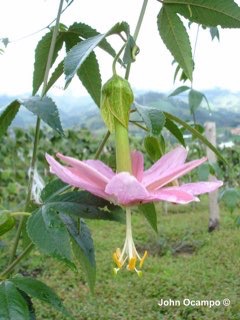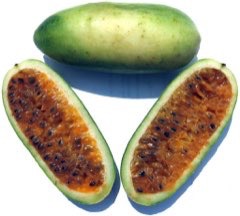 |
|
John Ocampo wikimedia.org |
 |
| wikimedia.org |
Translate this page:
Summary
Found in South America, Passiflora tarminiana or commonly known as Banana Passionfruit is a high climbing vine characterized by hairy stems and petioles. The leaves are three-lobed and also hairy. The flowers are large and pink, hang downwards, and the base has pale green bracts. The deep yellow to orange, oblong, aromatic fruits are eaten raw or made into desserts or drinks. Banana passionfruit is native to tropical South America and now widely cultivated throughout the world. It is also known for other common names such as curuba ecuatoriana, curuba India, curuba ecuatoriana, curuba quite?a, tacso amarillo, tumbo (Per?), and banana p_ka.
Physical Characteristics

 Passiflora tarminiana is an evergreen Climber growing to 10 m (32ft) by 0.5 m (1ft 8in) at a fast rate.
Passiflora tarminiana is an evergreen Climber growing to 10 m (32ft) by 0.5 m (1ft 8in) at a fast rate.
See above for USDA hardiness. It is hardy to UK zone 10.
Suitable for: medium (loamy) and heavy (clay) soils and prefers well-drained soil. Suitable pH: mildly acid and neutral soils. It can grow in semi-shade (light woodland) or no shade. It prefers moist soil.
UK Hardiness Map
US Hardiness Map
Synonyms
No synonyms are recorded for this name.
Plant Habitats
Edible Uses
Edible Parts: Fruit
Edible Uses: Drink Sweetener
Fruit - eaten raw or used in ice creams, fruit salads, pies, jellies, to make drinks etc[301 ]. The yellow, oblong, aromatic fruits are highly prized for their juice[301 ]. The fruit is about 100 - 140mm long and 35 - 45mm wide[968 ]. The fruits of this species are a deep yellow to orange colour, the pulp is less aromatic and tart than the flesh of the pale yellow fruits of Passiflora tripartita mollissima, but is also somewhat inferior in flavour[968 ]
References More on Edible Uses
Medicinal Uses
Plants For A Future can not take any responsibility for any adverse effects from the use of plants. Always seek advice from a professional before using a plant medicinally.
None known
References More on Medicinal Uses
The Bookshop: Edible Plant Books
Our Latest books on Perennial Plants For Food Forests and Permaculture Gardens in paperback or digital formats.

Edible Tropical Plants
Food Forest Plants for Hotter Conditions: 250+ Plants For Tropical Food Forests & Permaculture Gardens.
More

Edible Temperate Plants
Plants for Your Food Forest: 500 Plants for Temperate Food Forests & Permaculture Gardens.
More

More Books
PFAF have eight books available in paperback and digital formats. Browse the shop for more information.
Shop Now
Other Uses
References More on Other Uses
Cultivation details
The plant grows well at elevations between 2,000 - 3,000 metres or even more in the tropics, succeeding at lower elevations as it moves away from the Equator[968 ]. Requires a humus-rich, moist but well-drained soil and a position in dappled shade where it can grow up towards the sun[262 ]. Passiflora species tend to flower and fruit more freely when grown in soils of only moderate fertility[200 ]. Prefers a circumneutral soil, disliking very acid or very alkaline conditions[262 ]. Prefers a pH in the range 6 - 7, tolerating 4.3 - 8[418 ]. A vigorous and disease-resistant species, it has escaped from cultivation in some areas, particularly New Zealand and Hawaii. It can invade native habitats, especially woodlands, and has been declared a noxious weed in both Hawaii and new Zealand[968 ]. The plant shows more resistance to pests and diseases than the related Passiflora tripartita mollissima[968 ]. This species hybridizes easily with other species in the subgenus Tacsonia[968 ]. Hybrids with Passiflora mixta and Passiflora tripartita are fertile and show intermediate phenotypes[968 ]. Hybrids with Passiflora cumbalensis can also produce fertile seed[968 ].
References Carbon Farming Information and Carbon Sequestration Information
Temperature Converter
Type a value in the Celsius field to convert the value to Fahrenheit:
Fahrenheit:
The PFAF Bookshop
Plants For A Future have a number of books available in paperback and digital form. Book titles include Edible Plants, Edible Perennials, Edible Trees,Edible Shrubs, Woodland Gardening, and Temperate Food Forest Plants. Our new book is Food Forest Plants For Hotter Conditions (Tropical and Sub-Tropical).
Shop Now
Plant Propagation
Seed - best sown as soon as it is ripe along with the pulp which will help break down the seed coat and speed up germination[262 ]. Stored seed should be soaked for 24 hours in warm water and germination time can be reduced if the seed is then mixed with the juice of a fresh passion fruit (of any species)[262 ]. Even so, it can take 12 months for stored seed to germinate[262 ]. Place the seed tray in a shady position, maintaining a temperature around 19 - 24c[262 ]. Prick the seedlings out into individual containers as soon as they are large enough to handle and plant out when large enough[262 ]. Cuttings of young shoots, taken at the nodes. Layering. Very easy[262 ]. Air layering.
Other Names
If available other names are mentioned here
Banana passionfruit, Banana Poka, Curuba.
Native Plant Search
Search over 900 plants ideal for food forests and permaculture gardens. Filter to search native plants to your area. The plants selected are the plants in our book 'Plants For Your Food Forest: 500 Plants for Temperate Food Forests and Permaculture Gardens, as well as plants chosen for our forthcoming related books for Tropical/Hot Wet Climates and Mediterranean/Hot Dry Climates. Native Plant Search
Found In
Countries where the plant has been found are listed here if the information is available
Australia, Bolivia, Colombia, Ecuador, Guatemala, Hawaii, Mexico, New Zealand, North America, Peru, South Africa, Southern Africa, South America, Tasmania, USA, Venezuela,
Weed Potential
Right plant wrong place. We are currently updating this section.
Please note that a plant may be invasive in one area but may not in your area so it’s worth checking.
Plants have escaped from cultivation in several areas of the world[262 ], and the plant has been declared a noxious weed in America.
Conservation Status
IUCN Red List of Threatened Plants Status : This taxon has not yet been assessed

| Related Plants
|
| Latin Name | Common Name | Habit | Height | Hardiness | Growth | Soil | Shade | Moisture | Edible | Medicinal | Other |
| Passiflora actinia | Passion Flower | Climber | 10.0 |
8-11
| F | LMH | N | M | 3 | 0 | 1 |
| Passiflora antioquiensis | Banana Passionfruit | Climber | 5.0 |
10-12
| F | LMH | SN | M | 4 | 0 | 0 |
| Passiflora caerulea | Passion Flower, Bluecrown passionflower, Blue Passion Flower | Climber | 10.0 |
9-11
| F | LMH | N | M | 3 | 0 | 1 |
| Passiflora edulis | Passion Flower, Purple granadilla | Climber | 9.0 |
9-12
| F | LMH | N | M | 4 | 1 | 1 |
| Passiflora herbertiana | | Climber | 9.0 |
-
| | LMH | SN | M | 2 | 0 | |
| Passiflora incarnata | Maypops - Passion Flower, Purple passionflower, Apricot Vine, Maypop, Wild Passion Flower, Purple Pa | Climber | 6.0 |
7-11
| F | LMH | N | M | 3 | 3 | 0 |
| Passiflora laurifolia | Yellow Granadilla | Climber | 15.0 |
10-12
| F | MH | SN | M | 4 | 2 | 2 |
| Passiflora ligularis | Sweet Grenadilla, Passion Flower | Climber | 5.0 |
9-12
| F | MH | SN | M | 5 | 0 | 0 |
| Passiflora membranacea | Passion Flower | Climber | 5.0 |
8-11
| F | LMH | N | M | 3 | 0 | |
| Passiflora mollisima | Banana Passion Fruit | Climber | 5.0 |
5-9
| F | LMH | N | M | 3 | 0 | |
| Passiflora popenovii | Granadilla de Quijos | Climber | 8.0 |
10-12
| F | MH | SN | M | 4 | 0 | 0 |
| Passiflora quadrangularis | Giant Granadilla, Badea | Climber | 15.0 |
10-12
| F | MH | SN | M | 4 | 2 | 0 |
| Passiflora species | Passion Flower | Climber | 5.0 |
-
| F | LMH | N | M | 3 | 0 | |
| Passiflora tetrandra | | Climber | 9.0 |
-
| | LMH | SN | M | 1 | 0 | 2 |
| Passiflora tripartita mollissima | Banana Passionfruit | Climber | 5.0 |
10-12
| F | MH | SN | M | 4 | 0 | 0 |
| Passiflora umbilicata | Passion Flower | Climber | 5.0 |
8-11
| F | LMH | N | M | 2 | 0 | |
| Passiflora x colvillii | Passion Flower | Climber | 10.0 |
6-9
| F | LMH | N | M | 2 | 0 | |
| Passiflora x exoniensis | Passion Flower | Climber | 5.0 |
9-11
| F | LMH | N | M | 3 | 0 | |
|
Growth: S = slow M = medium F = fast. Soil: L = light (sandy) M = medium H = heavy (clay). pH: A = acid N = neutral B = basic (alkaline). Shade: F = full shade S = semi-shade N = no shade. Moisture: D = dry M = Moist We = wet Wa = water.

Expert comment
Author
Coppens & V.E.Barney
Botanical References
Links / References
For a list of references used on this page please go here
A special thanks to Ken Fern for some of the information used on this page.
Readers comment
| Add a comment |
|
If you have important information about this plant that may help other users please add a comment or link below. Only comments or links that are felt to be directly relevant to a plant will be included. If you think a comment/link or information contained on this page is inaccurate or misleading we would welcome your feedback at [email protected]. If you have questions about a plant please use the Forum on this website as we do not have the resources to answer questions ourselves.
* Please note: the comments by website users are not necessarily those held by PFAF and may give misleading or inaccurate information.
To leave a comment please Register or login here All comments need to be approved so will not appear immediately.
|
Subject : Passiflora tarminiana
|
|
|
|